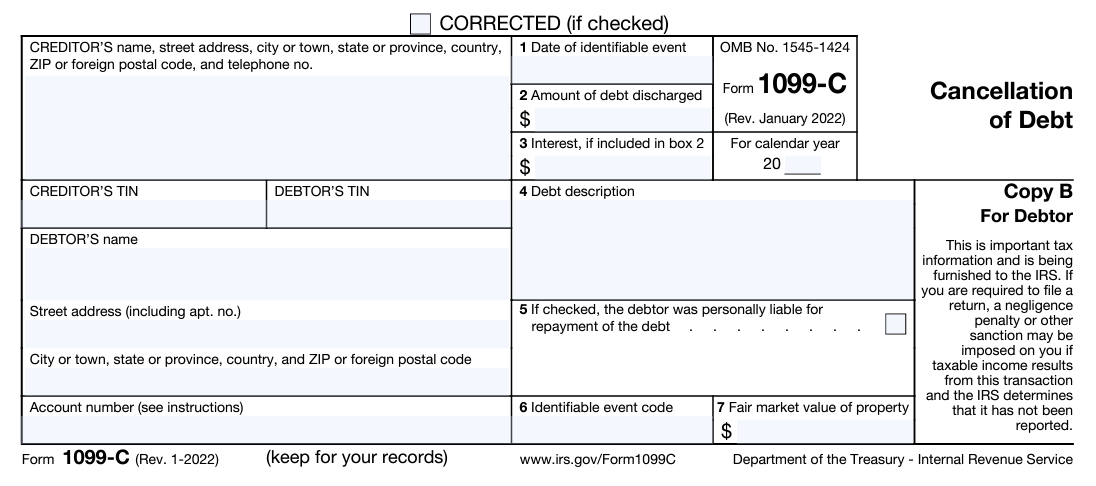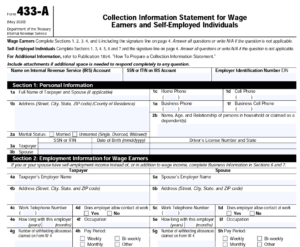Can Service Providers Issue a 1099-C for Unpaid Bills?
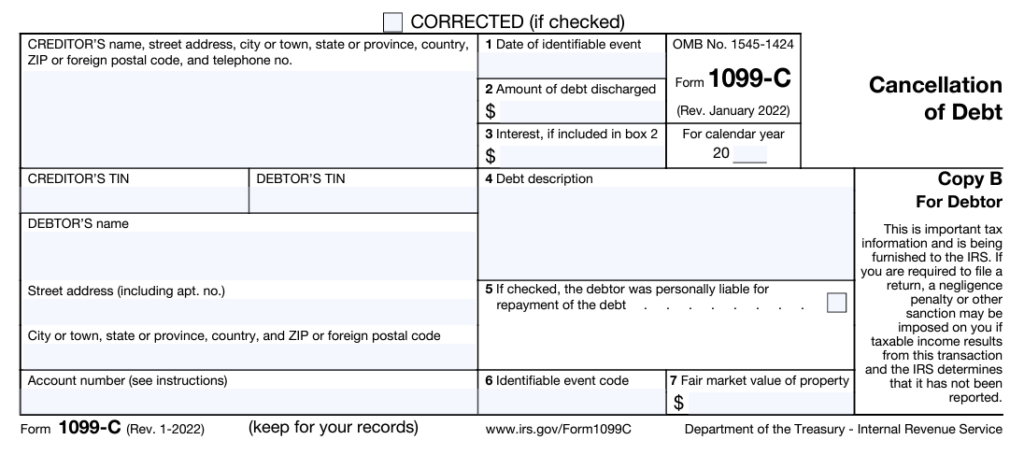
Social media never fails to provide the most false or misleading tax information. This post did not disappoint. The social media post said:

$130K in unpaid contracts over here.
I don’t argue. I have forgiven their debt on my end with a 1099-C.
Now it’s between them and the IRS beloveds. It’s above me now.
If you do B2B transactions do not argue. Make their debt to you taxable. They do not get to claim a tax break when they did not start or finish paying you.
Protect your business and your blood pressure 😊
The post was made by a service provider who had unpaid bills. The post had 20 comments and 597 likes. Almost 600 people saw this post, and thought 'this is really cool'. A few others commented that 'this was an education', and others stated that they were going to do this ASAP! Uhhh NO!!
Purpose of a 1099-C Cancellation of Debt
The IRS form 1099-C, Cancellation of Debt, is designed for financial institutions (such as banks) to report a cancellation of debt [usually related to non-payment] of $600 or more. This cancellation of debt, most often, is treated as taxable income to the debtor, and must be claimed on the tax return. A creditor/debtor relationship is established. There is a loan amount, loan payment terms, interest rate, and methods of resolution in the event of default (non-payment).
Who Can File a 1099-C
Internal Revenue Code 6050P makes a specific list of entities who can file a 1099-C:
- A financial institution described in section 581 or 591(a) (such as a domestic bank, trust company, building and loan association, or savings and loan association).
- A credit union.
- Any of the following, its successor, or subunit of one of the following.
- Federal Deposit Insurance Corporation.
- National Credit Union Administration.
- Any other federal executive agency, including government corporations.
- Any military department.
- U.S. Postal Service.
- Postal Rate Commission.
- A corporation that is a subsidiary of a financial institution or credit union, but only if, because of your affiliation, you are subject to supervision and examination by a federal or state regulatory agency.
- A federal government agency including:
- A department,
- An agency,
- A court or court administrative office, or
- An instrumentality in the judicial or legislative branch of the government.
- Any organization whose significant trade or business is the lending of money, such as a finance company or credit card company (whether or not affiliated with a financial institution). The lending of money is a significant trade or business if money is lent on a regular and continuing basis.
Please note that you do not see a service provider with an unpaid bill in the list.
Providing a Service does not create a Creditor/Debtor Relationship
When a service provider engages a client for services, It creates a provider/client relationship. A service provider agrees to perform a service in exchange for an agreed amount. There are remittance (payment terms), such as payment due in 15 days, due immediately upon completion, or due in advance. While this is a contract, it does not create a creditor/debtor relationship. The service provider is not lending money to the client.
Filing a False 1099-C Consequences
This service provider seemed really snappy and clappy, seemingly to believe that she will cause their client to have an unexpected tax bill. However, should she issue a 1099-C for an unpaid bill, there are consequences.
Internal Revenue Code 7434 states:
If any person willfully files a fraudulent information return with respect to payments purported to be made to any other person, such other person may bring a civil action for damages against the person so filing such return.
https://www.law.cornell.edu/uscode/text/26/7434
The person filing the false 1099-C can be liable for the GREATER of $5,000 or the sum of damages, costs of the action, and attorney's fees. A plaintiff (the one who received said 1099-C) has 6 years from the date the false 1099-C was filed or 1 year after the return would have been discovered with reasonable care. Oh yeah, the IRS wants a copy of the suit, as well.
It can be quite frustrating when you provide a service to your client, and they don't pay the bill. You can go through a collection agency to try to recoup your money. You cannot deduct the amount of unpaid funds, unless you're using the accrual method of accounting. The only reason it is a deduction for the accrual method is that you've already counted the income. Regardless, issuing a 1099-C is not the method for service providers to collect their unpaid funds.
If you are dealing with back taxes or unpaid tax debt, reach out to us! We're here to help!
The New Self Employed Covid Credit

Ahhh… Have you seen the ads?
“1099 Gig Workers Claim up to $32,000 with the ‘New’ Covid Self Employed Tax Credit (SETC).
Oy! I decided to write this blog post once I got a few inquiries from my clients. Quite frankly, these companies make my skin crawl. I’ve even seen influencers, who have ZERO experience with tax, telling their audiences to go ‘get this money’, BUT ... ‘check with your CPA first’. [Insert my best side-eye.]
The actual name of the credit is the Self-Employed Sick and Family Leave Credit. SETC is not a thing. If you ask a tax professional about the SETC, they’ll probably be confused, because that’s not the name of the credit. However, to gain understanding about this credit, I will use the Street Committee Name - SETC. Let’s talk about how we got here.
Employee Retention Credit Claims - FROZEN
In September 2023, the IRS ordered the immediate stop to Employee Retention Credit (ERC) processing. They received several millions of ERC claims, many of them fraudulent. Employers could still submit claims, but they would not be processed. FYI, Tax Year 2020 ERC claims need to be submitted no later than April 15, 2024. The credit is claimed on Form 7202.
ERC claims were lucrative, and these companies made a BOATLOAD of money, charging 20% of the credit received. If a client received a claim for $60,000, the companies would be paid $12,000. That's a heck of an incentive to submit fraudulent claims. Should the IRS come knocking, it would be at the employers' doors, not the company that fabricated the information on the claim. The IRS pumped all the brakes on that.
SETC is the new ERC
Since the ERC well dried up, these companies shifted their sights to the Self-Employed Sick and Family Leave Credit. Now Self-Employed individuals are being bombarded with advertisements of being able to get ‘up to’ $32,000 from the SETC. It only takes a few minutes to apply (insert affiliate link). You didn't think people were posting about it just to help - right? I'm not mad at anyone earning affiliate commissions. I do it all the time. I AM annoyed at promoting something that has serious consequences if the person doesn't get all the information. A tax credit is not the same as promoting the latest email marketing tool.
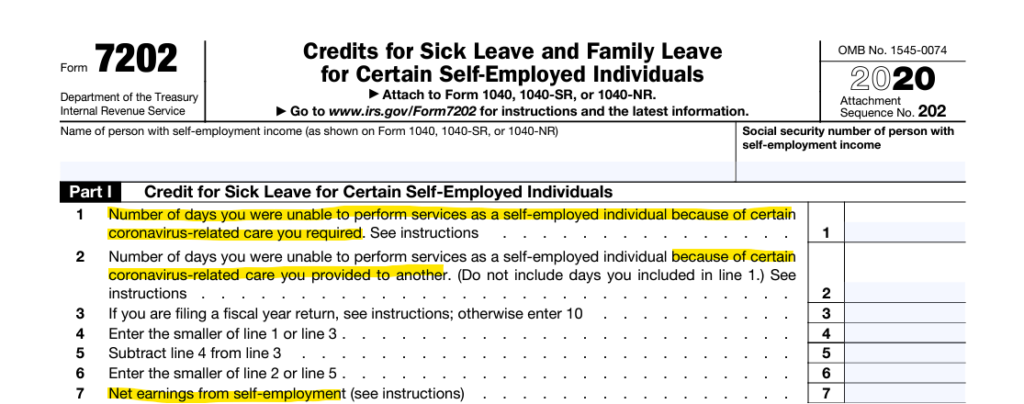
Under the 2020 rules, a self-employed individual could claim up to $15,110. For 2021, they could claim up to $17,110; hence the total $32,000. The clock is ticking on claiming the 2020 tax credit, so the ads are on fire.
Qualifications for Self-Employed Tax Credit
There are three main questions you have to answer to determine if you qualify for the credit.
- Were you unable to work because you had Covid?
- Were you unable to work because you had to care for someone with Covid?
- Did you earn a profit?
In 2021, the qualifications were tweaked a bit. In part II of the form below, Form 7202 specifies “January 1- March 31, 2021”, and also specifies caring for a son or daughter (see instructions). The instructions say: “because of certain coronavirus-related care you provided to a son or daughter whose school or place of care is closed or whose childcare provider is unavailable for reasons related to COVID-19 or for any reason you may claim sick leave equivalent credits.

Part III of the 2021 version of Form 7202 specifies April 1 through September 30, 2021, for yourself or care you provided to another. The section specifically for children was removed. The great thing about the credit is that you could separate the time you needed to care for yourself or another from the time you needed to care for your children.
Part III 2021 Form 7202

Plenty of Self-Employed individuals were impacted by Covid. I don’t know any that were not; however, being impacted by Covid did not automatically mean you qualified for the credit. Millions of self-employed individuals lost money in their businesses during Covid. If you look at both the 2020 and 2021 Form 7202, it asks for ‘net earnings’ from self-employment (amount of profit). If you claimed a loss, you did not qualify for the credit. The advantage of the 2021 version of the credit is that you could use net earnings from 2020. If you posted a loss in 2020, then you still did not qualify for the credit.
Be prepared for an audit
If you qualify for the credit and didn’t claim it, by all means, amend your return to claim your credit; however, I also caution you to be ready for an audit. The auditor will ask for bank statements to confirm revenue and expenses. They may also ask for proof that you had Covid, a family member had Covid, or that your childcare facility or school was closed. Closed daycare and schools won’t be hard, for sure. While your health information may be protected, your banking information is not. You have to be able to prove anything you claim on your return.
Don’t be duped into claiming false credits. The false claims are why there is a moratorium on the Employee Retention Credit. If the IRS or State comes knocking on your door (figuratively, they’re not coming to your house right now), but if you get the letter being notified of an audit, reach out to us at ETS Tax Relief to help you!
Statute of Limitations
The Statute of Limitations is critical in the fight against the IRS. It is important to know which statute of limitations applies to your situation.
Definition
In general, the Statute of Limitations refers to the amount of time a party can take action from the time a situation occurred. The IRS has different statutes of limitations by which to abide. The date the statute of limitations ends is called the Statute Expiration Date.
3-year Audit Rule Statute of Limitations
The IRS generally has three years to audit your return. They can add more years if they find a substantial error, but usually no more than 6 years. The IRS can go back FOREVA if they suspect fraud or criminal activity.
Substantial Understatement of Income
The statute of limitations for audit is extended to six years if you omit (leave off) more than 25% of your gross income.
In tax year 2021, Jane earned $150,000, but only reported $110,000. The difference is $40,000 (~27% of $150,000). Since the difference is greater than 25%, the six year statute applies. Jack also earned $150,000, but reported $114,000, a difference of $36,000 (~24% of $150,000). The three year assessment would apply to Jack's situation since the difference is less than 25%.
Basis Overstatement
Congress decided in 2015 that basis overstatement produces an understatement of income, and extended the statute of limitations to six years vs. three years.
Example: Let’s assume you sell an investment property for $1 million. You claim your basis (the amount you invested) is $800,000, but it’s actually much lower at $250,000. The impact of your overstatement of basis is that you paid tax on $200,000, when you should have paid tax on $750,000. The IRS has 6 years to figure that out.
Refund Statute of Limitations
The Refund Statute Expiration Date (RSED) refers to the amount of time a taxpayer has to claim a refund. Generally, the refund statute of limitations is three years from the date a tax return is due OR within 2 years after the overpayment of tax.
Let’s assume you have not filed your 2017 tax return and you were due a refund. The 2017 tax return filing deadline was April 17, 2018. The last day to claim your 2017 tax refund was April 18, 2021. If the refund wasn't claimed by April 18, 2021, the statute of limitations has expired. You can no longer claim the refund. #Ewwww
Assessment Statute Expiration Date (ASED)
The IRS has three years from the time a return is filed to assess a tax. A tax assessment is the statutorily (by law) required recording of the tax liability. According to §6203, the assessment is made by recording the taxpayer’s name, address, and tax liability. In other words, the IRS has a required statute of limitations to record your tax within three years of the due date of your return, or from the time the return is filed (whichever is later). The Assessment Statute Expiration Date (ASED) on a tax return timely filed by Apr 15, 2022 is April 15, 2025.
Collections Statute of Limitations
The IRS generally has a statute of limitations of 10 years from the date the tax is assessed to collect a federal tax debt. The IRS has to write off any tax debt that's not paid by the end of the 10-year statute. It disappears like it never existed. There are situations that can toll (extend) the Collection Statute Expiration Date (CSED) - bankruptcy proceedings, for example.
Statute of Limitations on Unfiled or Fraudulent Returns
There is no statute of limitations on fraud. If you filed a fraudulent return, it’s as if you never filed a return at all.
Examples
- Tax preparers go to jail regularly for filing fraudulent returns on behalf of their clients. Sometimes the clients are aware. Sometimes they are not. Assume you are a victim of a preparer who filed a tax return containing fraudulent business losses to get you a bigger refund. Even though you may not have known the return contained fraudulent information, there is still no statute of limitations on the tax return. Theoretically, the IRS can find out about the return 10 years later, and still require the taxpayer to pay back any refund they were not entitled to receive.

- The statute of limitations never starts on a return that is never filed. The IRS may file a Substitute for Return (SFR), but that doesn’t count as a filed return either. The SFR doesn’t take into account any tax credits or deductions to which you may be entitled. The IRS uses the income reported by third parties and assesses the tax based on that. It’s important to note that filing an incomplete return, such as an unsigned return, does not count as filing a return.
The statute of limitations listed above are the most common statutes taxpayers experience. It’s important to know the statutes of limitations that apply to your situation. If you have received a letter from the IRS or have unresolved tax debt, reach out to us at 877.4TAX411 (877.482.9411).
How PPP Loan Fraud Gets Caught
Let me start by saying that I’m neither a detective, nor an attorney. I’m a tax professional. However, you don’t really need to be anything special to know how government systems work, especially when it comes to money. As it pertains to the Paycheck Protection Program, the Department of Justice immediately established a fraud detection unit when the CARES Act was passed in March 2020. The Inflation Reduction Act of 2022 increased the time to prosecute PPP Loan Fraud to 10 years. That has some people shaking in their boots. With this post, I’m going to share how PPP Loan Fraud is getting caught.
Loan amount over $2 million
When the Payroll Protection Program (PPP) was created, then Secretary of the Treasury Steve Mnuchin announced that ALL PPP loans $2 million or more WILL be audited. There was no flexibility in that statement. That’s where they started, not where they stayed. People and companies that received loans in the millions were audited. If they received loans based on fraudulent information or misused funds… #Busted!
Mismatch Schedule C
In my opinion, this is the most common way PPP scammers will get caught. PPP Loans required Sole Proprietors, Independent Contractors and Single Member LLC owners to submit the Schedule C in the loan application. In the initial round of PPP disbursements, your loan amount was based on the amount of profit you earned. The rules changed once President Biden was elected. The loan was based on the amount of gross revenue shown on the Schedule C. In either case, the max amount of the loan was based on $100,000, so that the max loan amount one could receive is $20,833.
People were submitting Schedule Cs to the bank that had not actually been filed. Because the banks were under pressure to get the money out quickly, there just wasn’t time to verify the information at the time of the loan application. An applicant could submit a Schedule C even if they had not filed their taxes yet. PPP scammers received loans of approximately $20,000 because they claimed they earned $100,000 in income.
One of the forms you signed to get the PPP loan was a 4506-T. This form allows certain entities to pull your transcripts from the IRS. If your Schedule C doesn't match your application, or you don’t file a Schedule C at all… #Busted.
Mismatch Employment Tax Returns (Form 941)
The purpose of the PPP Loan was to assist small businesses in continuing to pay their employees during the Covid Emergency. The loan was based on the amount of your payroll. People claimed fraudulent employees and created fraudulent employment tax returns (Form 941) showing employees and payroll amounts that didn’t exist. I had a caller tell me that someone on Clubhouse was advertising that they would create the fraudulent 941s for you to use to support your loan.
Employment Tax Returns (form 941 filed quarterly) detail: wages you paid, income taxes, social security tax, and Medicare tax withheld. This report determines how much money your business should have paid to the government (Federal and State). The government compares what you claim on your 941s to what they have in their records. They look to see if they have records of 941s AND the money you claim to have paid to the government. Once the government determines that you have neither filed the returns, nor paid the withheld taxes… #Busted!
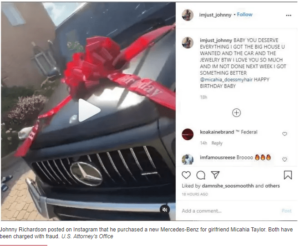
Social Media
Social Media has to be my favorite method of the government catching thieves. These days, people can’t keep ANYTHING to themselves. They gotta flex for the ‘Gram. Oy! The government will use your Social Media posts to convict you. People were using their fraudulent PPP loan money to buy ridiculous things - expensive cars and jewelry, homes, and clothes, then posting about it on social media. There was even a guy who posted about how he was committing fraud on YouTube. What?!?! … #Busted!
Bank Secrecy Act
One of the things that PPP Loan Ballers did was take out large sums of money. The Bank Secrecy Act “requires U.S. financial institutions to assist U.S. government agencies to detect and prevent money laundering. Specifically, the act requires financial institutions to keep records of cash purchases of negotiable instruments, file reports of cash transactions exceeding $10,000 (daily aggregate amount), and to report suspicious activity that might signify money laundering, tax evasion, or other criminal activities.”
PPP Loan fraudsters were quick to withdraw money. Any time you withdraw $10,000 or more in cash, the bank reports it to the IRS. Banks were looking at accounts getting PPP loan money and then watching the activity afterward. Guess what… #Busted!
Look, lying on loan forms or any federal form is a felony. If you have to lie on a loan form, then you really don't qualify for the loan. You can go to prison. Many people thought that the government wouldn't prosecute loan scammers. They also thought that if they got caught, they would just have to pay the loan back under favorable terms. Yeah... No. Just don't lie. It's that simple.
IRS Gets $80 Billion For What?
You’ve seen the news. You’ve seen the lightning flashing, and thunder roaring. You’ve heard the cries in the street!
“Oh my God! The IRS is hiring 87,000 people to come get us!”
“They’re coming for the poor and middle class!”
“Audits are going to increase!”
Lions, tigers, and bears! Oh MY!
The IRS is getting $80 Billion
Yes, the IRS is getting $80,000,000,000. That’s what $80 Billion actually looks like numerically. Anywho, this $80 Billion will be dispersed over 10 years. Here is a breakdown of the funding: Enforcement $45.6 Billion, $25.3 Billion for Operational support, $4.8 Billion to modernize IRS business systems (administration of taxpayer services, operations, and cybersecurity).
Backstory: The IRS has been underfunded for DECADES. They have antiquated systems that rival MS DOS. The irony is not lost in that systems received the least amount of funding. The IRS is also dealing with the Great Resignation.
The IRS is hiring 87,000 new Agents
Cool your jets! 1. These are not all going to be auditors. 2. They aren’t being hired Tuh-Day!
The IRS is facing the normal attrition of retiring individuals. They are also facing the same hiring struggles as every other business.
“It’s hard to hire for the IRS, when Target is paying $20 per hour”. ~Chuck Rettig, Commissioner of the IRS
There isn’t going to be a formation of an Army of Revenue Agents looking like the First Order in Star Wars, at least not TUH-DAY!
More Audits?
In the IRS’s strategic plan from a few years back, they told us they were going to be targeting high income non-filers. That plan has not changed.
The headline of the Treasury Inspector General for Tax Administration (TIGTA) report from May 2020 was: “High-Income Nonfilers Owing Billions of Dollars Are Not Being Worked by the Internal Revenue Service”. Guess what’s going to be happening now?
The headline of TIGTA’s December 2020 report was: “Billions in Potential Taxes Went Unaddressed From Unfiled Returns and Underreported Income by Taxpayers That Received Form 1099-K Income”.
The enforcement initiatives are not a surprise. Now, everyone is yelling, “Get your documentation in order”. If you prepare your return as if the IRS will show up tomorrow, they could hire a million revenue agents, which wouldn't matter to you.
Enforcement
The lion's share of the funding is going to enforcement. The goal of enforcement is to close the tax gap. According to the Treasury Department, the tax gap was $554 Billion in 2019. Approximately 84% percent of taxes owed in tax-year 2019 were actually paid or collected.
During the pandemic, the government stopped collection action. Since the pandemic is ‘over’, collection actions have resumed. If you have an outstanding tax liability, the IRS is pressed to get some sort of resolution - whether it’s an installment agreement or Offer in Compromise. Your goal as the taxpayer is to pay the least amount possible. The IRS's job is to collect as much as possible.
PPP Loan Fraud
Ahhh, we can’t talk about enforcement without talking about PPP Loan fraud! What types of PPP loan applications do you believe dominated the fraud? It was the Schedule C application. People were promoting PPP loans like they were an MLM like this case. People with absolutely NO financial background were out in these streets selling PPP loan application assistance like candy, helping people apply for fraudulent loans in exchange for a cut of the proceeds. The thieves submitted fraudulent Schedule Cs and false employee tax returns (941s) to obtain money they weren’t entitled to receive. Now the chickens are coming home to roost. A New York Times article (Aug 16, 2022), states:
There are currently 500 people working on pandemic-fraud cases across the offices of 21 inspectors general, plus investigators from the F.B.I., the Secret Service, the Postal Inspection Service and the Internal Revenue Service.
It also states:
The federal government has already charged 1,500 people with defrauding pandemic-aid programs, and more than 450 people have been convicted so far.
The Inflation Reduction Act increased the time for the government to prosecute PPP Loan thieves to 10 years. They stole taxpayer money. Should the government not work to get it back?
Status of the IRS

The image above is of the cafeteria in the Austin Tx processing center. According to the Washington Post, as of July 29, the IRS had a backlog of 10.2 million unprocessed individual returns. The IRS has severely outdated systems - paper-people based systems, fax machines, and the lack of ability to scan documents in the computer. Paper returns have to be manually keyed in. The pandemic only exacerbated the situation.
You may not like it, but the IRS needs this funding. It's that simple. The changes will not happen overnight. You have time to get your documentation life together, so that in the event you are audited, you'll be ready.
All You Need to Know About Currently Not Collectible Status
When a taxpayer can’t afford to pay a delinquent tax bill, one of the first questions that cross their minds is: Am I going to jail? We don’t have a debtor’s prison in the United States. The only people who go to jail for not paying taxes are the ones who actively and illegally attempt to dodge their tax requirements. There are people who actually cannot afford to pay their tax liability. That taxpayer can be placed in Currently Not Collectible (CNC) status. While this can provide taxpayer relief, it’s not permanent and it’s not a guarantee.
What is Currently Not Collectible Status?
Currently Not Collectible (CNC) status temporarily delays the collection of an outstanding tax debt. The IRS can place a taxpayer in CNC status if it is determined that a taxpayer cannot afford to pay their delinquent tax bill. The taxpayer will remain in CNC status until the taxpayer’s financial situation improves. Currently Not Collectible status doesn’t remove the tax debt, it temporarily delays collection. The IRS will file a lien if you owe $10,000 or more, but the actual collection efforts will be delayed. Penalties and interest will continue to accrue during the CNC period, as well. The delay means that they won't levy your income or seize your property. The Collection Statute Expiration Date (CSED) clock continues to run. The IRS has 10 years from the date of assessment to collect a debt. Currently Not Collectible status does NOT stop that clock from running.
Who is eligible for Currently Not Collectible Status?
Just saying you can’t afford to pay your taxes isn’t enough to be placed in CNC status. A taxpayer who claims they can’t afford to pay their taxes will be asked to provide a Collection Information Statement (CIS) Form 433-A, 433-B, or 433-F. This Collection Information Statement details your financial situation - living expenses, assets, debts, and monthly income. Assets can include a wide variety of things - cryptocurrency, weapons, or a retirement account. The results of the CIS will determine if the taxpayer is eligible for CNC status.
National and Local Standards
As stated earlier, you can’t just ‘say’ you can’t afford to pay your taxes. You have to be able to prove that you can’t afford to pay your taxes, but this isn’t as easy it seems. The IRS has a guideline of allowable expenses, based on national and local standards. Items such as food, clothing and services, household supplies, and personal care products have a national standard for the allowable amount. There are national standards for healthcare and medical supplies. The amount of the standard takes into consideration the area of the country in which you live. The National Standard for housing in California is higher than in Virginia, for example. The standards also vary by county as well.
Monthly Disposable Income
The goal in completing the financial statement is to determine the taxpayer’s Monthly Disposable Income (MDI), which is the amount of money you have left after your allowable expenses are deducted from your income on a monthly basis. Your location and family size play a large part in calculating the amount of allowable expenses. If your MDI is zero or less, then you have a better chance to qualify for CNC. If your MDI is $1 or more, then you don’t qualify for CNC. Because you could actually be paying more for expenses than the IRS allowable amounts, your MDI may be different from the IRS's calculations.
Let’s look at an example: Jerry owes the IRS $27,000. The IRS is asking for $250 per month for payment. Jerry says, ‘I don’t have that money.’ Jerry is single, living in Alexandria, VA. He reports his expenses as this:
Monthly income: $4600
Rent and utilities: $3000 ($2500 rent + $500 Utilities)
Car Payment: $533
Car Insurance: $300
Food: $800
Credit card payments: $400
____________________
-$133 (monthly deficit)
However, the IRS reviews their National and Local standards for expenses. The IRS's CIS looks like this:
Monthly Income: $4,600
Rent and Utilities: IRS Allowable $2738
Car Ownership Allowable Expenses: $907
Food and supplies Allowable expense: $785
_______________________
$170 monthly disposable income
While Jerry doesn't have the $250 the IRS was initially asking for, based on the IRS's standards, he does have $170 monthly disposable income to pay toward his outstanding tax debt. This is when Jerry should contact us for assistance.
What about personal debt?
Personal debt tends to be a sticking point for taxpayers. As far as the IRS is concerned, they are your number one creditor. The IRS tends to ignore payments on personal debts such as credit cards or personal loans. There are some cases where the IRS will take those payments into consideration, but generally, payments on personal debt do not count toward your monthly expenses.
CNC is not permanent
The purpose of CNC is to provide relief to the taxpayer who is in a bad financial situation. The IRS will review the CNC status on an annual basis to see if your financial situation has changed. They may take refunds and apply them to the outstanding tax debt. It is important that the amount of tax debt does not continue to increase. The IRS may determine that you are not eligible for CNC status if your tax liability increases every year. You must remain current with your filings as well.
Trust Fund Recovery Penalty
Storytime: I was perusing my daily news and came across a story of a business owner who was sent to jail for not paying employment taxes. On June 30, 2022, Frank Morrison, former owner of Thirsty’s Bar was sentenced to 13 months in Federal Prison for Failure to Withhold, Properly to Account for, and Pay over Tax.
What did he do?
Mr. Morrison withheld Federal Income, Social Security, and Medicare taxes from his employees’ paychecks, but FAILED to send the money to the government. Let's not call it a failure. That sounds like a mistake. He just didn't do it.
Anywho, Mr. Morrison withheld the money from the paychecks. Instead of paying it to the government the way he was supposed to, he decided to use the tax money for his personal expenses.
He stole from the government and his employees
We already know that not turning the money over to the government is wrong, but what EXACTLY is the problem? When employees file their tax returns, they will either be due a refund or they will have a tax liability reduced by the amount of tax paid through withholdings. The government will issue a refund on tax money they never received. In the case of a tax liability, the Treasury Department is assuming they have a certain amount already in the treasury from withholdings. The taxpayer to pays the balance, and the government is short. We pay into the Social Security system and expect to be able to withdraw from it when we reach retirement age. Imagine submitting for Social Security only to find that you have no credits. Either way, the math ain’t mathing!
Trust Fund Taxes
Taxes withheld from an employee’s paycheck are called Trust Fund Taxes. Trust Fund Taxes consist of Federal Income Tax, Social Security Tax, and Medicare Tax - what we commonly call payroll taxes. An employer has the added responsibility of withholding taxes from the employee’s paycheck and sending the money to the Treasury at the prescribed time. The taxes are called Trust Fund Taxes, because they are held “in trust” until they are paid to the Treasury. Both the government and the employee are trusting the employer to do that.
Employers must pay the employee’s Trust Fund Taxes, along with the employer’s portion of Social Security and Medicare taxes to the Treasury through the Federal Deposit System.
Trust Fund Recovery Penalty
Through Internal Revenue Code (IRC) 6672, Congress established Trust Fund Recovery Penalties. The penalty was designed to encourage business owners to promptly pay Trust Fund Taxes. The Trust Fund Recovery Penalty is a “pecuniary penalty’, which means the government is penalizing the offender for actual monetary loss for unpaid trust fund taxes.
The Trust Fund Recovery Penalty is equivalent to the amount of the unpaid balance of the Trust Fund Tax, which is based on unpaid income taxes withheld and the employer portion of withheld FICA Tax. In other words, you're going to pay double. Let's assume you owe $1,000 in Trust Fund Taxes and don't pay. You will then have to pay $2,000 - the $1,000 you owe + $1,000 in penalties.
Who can be assessed the Trust Fund Recovery Penalty?
This will throw you for a loop! The Trust Fund Recovery Penalty can be assessed against anyone who is responsible for collecting or paying trust fund taxes but willfully fails to do so. That could include officers of a corporation, employees or contractors with signature authority over bank accounts, bookkeepers, or accountants.
Willfully is defined as voluntarily and intentionally doing something that is against the law. It means the person knew or should have known the requirements of trust fund taxes, but ignores the law. In Mr. Morrison's case, he committed this offense from 2008 to 2020. If willful was a person, he's it.
What happens when the Trust Fund Recovery Penalty is assessed?

The person(s), against whom the Trust Fund Recovery penalty is assessed, will receive a letter from the IRS. After waking up from passing out, one has 60 days from the date of the letter to appeal (75 if outside the US). If one does NOT respond, the tax will be assessed and a Notice and Demand for Payment will be sent.
Once the penalty is assessed, the IRS will start collection action against the responsible person(s). This could be business or personal assets, including filing a tax lien or seizing said assets. Please note that Trust Fund Recovery Penalties generally can NOT be discharged in bankruptcy.
Back to Mr. Morrison
Not only is Mr. Morrison going to prison for 13 years, he must also pay a fine of $200,000, $684,927.56 in restitution to the IRS, and $100 assessment to the Federal Crime Victims Fund. Going to jail does NOT remove the debt. It will be waiting for him when he gets out. Because of his age, it is possible Mr. Morrison may die in prison. The debt isn't automatically forgiven. The IRS can pursue his estate.
At this point, you may be wondering if all Trust Fund Recovery Penalty cases result in jail time. The answer is no. Generally speaking, when small business owners don't pay over trust fund taxes, they are usually using the money to keep the business going - whether in operations or payroll. The belief is 'I'll just do it this one time, and then I'll pay it back'. That normally doesn't happen. For situations like this, the responsible persons generally aren't prosecuted, but the money still has to be paid. The IRS usually reserves prosecution for those special folks like Mr. Morrison, who use the money for personal gain.
What’s the takeaway?
Don’t steal the employees' or the government’s money! Easy enough. But seriously, if the IRS is going to pounce on you and show you no mercy, it would be with Trust Fund Recovery. They are aggressive in their trust fund efforts. The best way to stay out of trouble is to not get in it in the first place.
TIP: Keep your payroll funds separate from your operating expenses to keep you from spending money that isn’t yours to spend.
What's the solution?
If you're having issues with owing back payroll taxes, the best thing to do is tackle it immediately. There are options for resolving the penalty issue, but it can be complex. If you’ve got one of those letters, don’t pass out. Schedule a call with us to help you!

